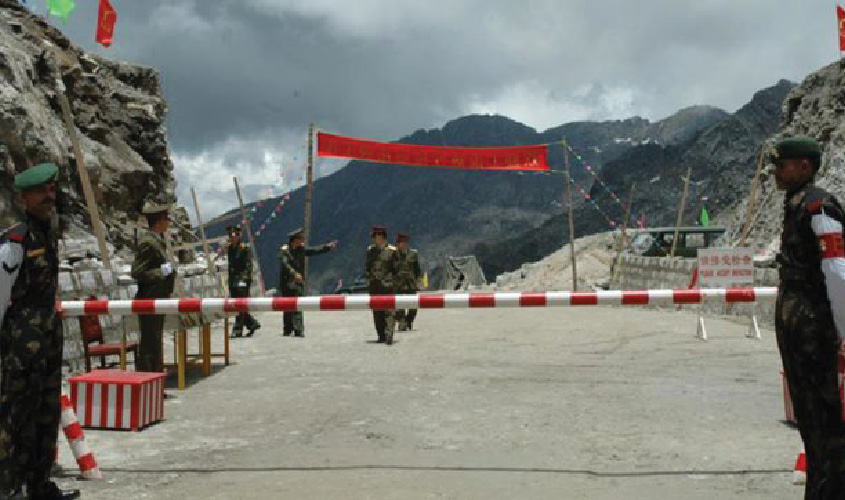China’s strategic highways have extended not just within and across Tibet, but also to the Nepal border.
| T |
he situation along India’s border in the eastern sector with China continues to remain indeterminate yet serious, militarily. Recent reportage of the Indian Army beefing up its troop presence in the Arunachal sector adjoining the Tibetan region, including at the tri-junction between India, China and Myanmar signals that Sino-Indian tensions have not eased much.
While India appears to be undertaking short-term reactive steps, China, since 1999, has been working on its long-term “Great Western Development” initiative and strategy, Xibu Da Kaifa. The rationale and implementation of this project launched by the Chinese government nearly two decades ago have been the foundation of the blizzard-like infrastructure stack-up in the Tibet Autonomous Region adjoining India.
The most recent illustration comes in form of a declaration by Chinese local authorities, stating that from 2012-17 the total length of ongoing sealed-road construction in Tibet was extended by 24,300 km. Resultantly, the total length of sealed-roads constructed across Tibet stands at 89,504 km. The average increase of highway and subsidiary roads network in the Tibetan region is 4,861 km according to China’s regional transportation department. The expected target of the sealed-roads network inside entire Tibet to be completed by the end of 2018 is 96,000 km. Significantly, the rural interior areas of Tibet have over 60,000 km of road network.
The Chinese government, as per state-run and controlled media, has spent more than 146.3 billion yuan ($23 billion) in fixed-asset investment in transportation infrastructure since 2012. In the current year alone, it plans to invest 68 billion yuan in the transportation sector.
In sharp contrast, India still seems to be struggling to put in place and execute a vast plan to develop, on a war-footing, its own connectivity along and across the long frontier with Tibet in order to close the ever-widening “infrastructure gap” with Beijing. The jaded and laid-back approach adopted by India’s Border Roads Organisation (BRO)—a quasi-military set-up established in 1960, tasked with developing and maintaining strategically vital infrastructure in the border areas, is not helping India’s case either.
In my book China’s Military Modernisation and Strategy published in 2011, research demonstrated that China had developed 58,000 km of road network in Tibet. Seven years down, while China nears touching the figure of 1 lakh km of sealed-road network, India still appears to be struggling in boosting its border roads. The latest extended deadline given to BRO for several critical high-altitude border links is 2020-21.
As for Tibet, seven major high-level roads have been opened to traffic in the past five years, including those linking Lhasa to Nyingchi, the airport to downtown of Xigaze, and the Gonggar airport in Lhasa to the Tsetang Township. By ramping up Tibet’s modern infrastructure comprising railroads, airports, and highways, China apparently is preparing to position itself to rapidly move in large numbers of additional forces to the border areas with India during the build-up of a conflict.
The rapid build-up of China’s national road and rail transport system has greatly enhanced the Chinese army’s land-based transport capabilities. Many key civilian highway and railway projects, especially trunk rail lines and inter-provincial highways linking interior and outer areas have been constructed to military specifications, which can be turned over to the PLA in the event of war. This argument gets reinforced by Chinese strategic analyst Zhao Gancheng’s statement when he says, “Highways in Tibet…can be used by armoured vehicles and as a runway for planes to take off when it has to serve a military purpose.” Besides, what aids China naturally is that its forces control the heights along the frontier, while the Indian Army remains perched largely at lower levels.
China’s strategic highways have extended not just within and across Tibet, but also to the Nepal border. Termed a first-tier highway, the 25-meter wide National Highway 318 (G318) runs from Shanghai to Zhangmu on the China-Nepal border. A section of this four double-lane highway links to the Nepalese border. Running very close to the border with India, the G318 connects the border town of Zhangmu with Lhasa and could link the future cross-border Sino-Nepalese railway.
As I argued in my book China’s Military Modernisation and Strategy, India cannot afford to discount the exigency of China’s massive blitzkrieg in the name of air, road, and rail-networked infrastructure all along its adjoining border areas. The extent of logistics infrastructure development in Tibet is an indicator of the impetus being made available to the Chinese army’s logistics capability, in turn, enhancing its operational capability for future mobile wars. After all, the infrastructure stack-up pumped inside Tibet by China is well beyond the genuine needs of either Tibet or the Tibetan people.
Dr Monika Chansoria is a Tokyo-based Senior Visiting Fellow at Japan Institute of International Affairs (JIIA)

